Hitting the ball fat is no fun. A fat shot just doesn't feel right coming off of the club face, and the ball will almost always fall from the sky prior to reaching the target. Use the instruction below to iron out any errors in your mechanics that may be causing fat shots and you will be able to limit the number of times you make this frustrating mistake.
One of the frustrating aspects of hitting fat shots is that you will probably feel like you are close to making a good swing – and you probably are right. While the result of a fat shot can look terrible when your ball only flies a few yards, it doesn't necessary mean that your swing is actually that far off track. Since hitting the turf only an inch or so behind the ball can turn an otherwise good swing into a bad one, there is very little margin for error. By correcting even small mistakes in your swing technique you can start to remove the fat shots from your game and hit the ball more reliable distances hole after hole.
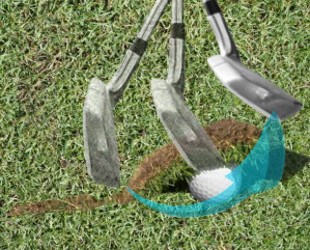
Unfortunately, it is possible to hit fat shots with each and every club in the bag. Most golfers think about irons when they remember shots that they have hit fat in the past, but it is also a problem with the driver – and yes, even the putter. Even having just one or two fat shots pop up during a round can do major damage to your scorecard, so it is important that you iron out your technique and do your best to avoid making this mistake on the course.
In golf, a fat shot is one where you hit the ground before hitting the ball. In almost all cases – with one notable exception, which we will cover later – hitting the ball fat is a bad thing. A fat shot is likely to fall short of the target, and depending on how fat you hit it, the ball may not travel more than a few yards in front of you. While even the best golfers are prone to hit a fat shot from time to time, limiting these mistakes in your game is an important step toward lower scores.
This article is going to cover the topic of fat shots from a variety of angles. First, we’ll talk what it is that causes fat shots. There are a number of potential causes, so the underlying reasons for your fat shots may be different than the issues faced by another player. From there, we will also discuss situations that make it more likely that you’ll hit the ball fat, and we will provide a couple of practice drills to help you cut down on these errors. Finally, we will get into the topic of fat shots in the short game, as this mistake is just as important on short shots as it is with full swings.
All of the content below is based on a right-handed golfer. If you happen to play left-handed, please take a moment to reverse the directions as necessary.
— Possible Causes of Fat Shots
There are a variety of ways in which your swing can go wrong on any given shot. Some of those mistakes will lead to fat shots, so we’d like to highlight the issues to watch out for in this section. If you are currently dealing with a lot of fat shots in your game, there is a good chance one of the issues below is to blame.
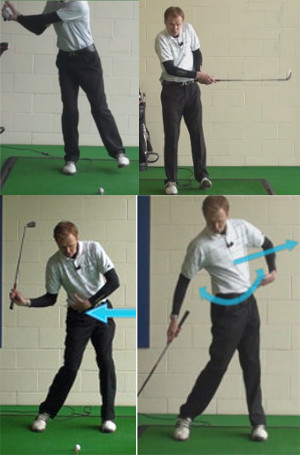
| GOLF FIXES BY PGA PROS |
|---|
| Cause and Cure Chip Shots Fat and Thin | Video | Article |
| Correct Fat or Thin Chip Shots | Video | Article |
| How to Fix the Problem of Chip Shots Fat and Thin | Video | Article |
| Potential Causes And Fixes The Fat Golf Chip Shots | Video | Article |
| What are Golf Fat Shots and How Women Golfers can Correct these | Video | Article |
| Problem and fix – Chip shots fat or thin, Golf | Video | Article |
| Weight Falling Back Causes Fat Shots | Video | Article |
| Problem And Fix Golf Chip Shots Fat Or Thin Golf | Video | Article |
| Causes And Cures Of Golf Fat Shots | Video | Article |
| Causes and Cures: Fat or Thin Chip Shots, Golf | Video | Article |
| Three Likely Problems For Golf Fat Shots | Video | Article |
| Causes and Cures: Fat Shots, Golf | Video | Article |
| Cure For Fat And Thin Golf Shots | Video | Article |
| LESSONS |
|---|
| Fat Golf Shots In The Golf Short Game | Video | Article |
| Hitting Fat Shots On The Golf Course Can Ruin Your Game | Video | Article |
| Hitting Your Golf Iron And Hybrid Shots Fat | Video | Article |
| Fat Shots With A Golf Putter – Yes It Happens | Video | Article |
| Judging The Conditions To Avoid Golf Fat Shots | Video | Article |
| Stop Hitting Golf Wedge Shots Fat – Heavy – Behind | Video | Article |
| The Dreaded Fat Shots With A Golf Driver | Video | Article |
| Top Five Tips On Fat Shots With Drivers, Irons, And Putters | Video | Article |
| Causes Of Fat Golf Chipped Shots | Video | Article |
| 5 Potential Causes Of Golf Fat Shots | Video | Article |
| Equipment Issues Can Cause Golf Fat Shots | Video | Article |
| Beginner Golf Tip: What Causes Topped and Fat Shots? | Video | Article |
| Some Quick Fat And Thin Golf Definitions | Video | Article |
| Stop Hitting the Ball Fat with this Golf Drill | Video | Article |
| Fat Shot Lesson | Video | Article |
| What Fat Golf Divots Show | Video | Article |
| Fat Shot Lesson | Video | Article |
| What Fat Golf Divots Show | Video | Article |
| Fat Shot Lesson | Video | Article |
| YOUR GRIP |
|---|
| What Are The Reasons And Benefits To Having Fat Or Thinner Grips For Golf Clubs And Putters | Video | Article |
| PRACTICE DRILLS |
|---|
| An Easy Drill Technique To Prevent Golf Fat Shots | Video | Article |
| Golf Tip Fix Hitting the Ball Fat With This Simple Drill | Video | Article |
| New Techniques To Stop A Fat Golf Shot | Video | Article |
| The Causes Of A Fat Golf Shot | Video | Article |
| Fat Golf Shot Drill: Finishing line hands win the race | Video | Article |
| Fat Golf Shot Drill: Introduction | Video | Article |
| Fat Golf Shot Drill: Right heal up at address and impact | Video | Article |
| Fat Golf Shot Drill: Stone ahead drill | Video | Article |
| Fat Golf Shot Drill: Towel 6 inches behind ball | Video | Article |
| Fat Golf Shot Drill: Walk through finish | Video | Article |
| Golf Bunker Practice Drill, Never Hit Another Bunker Shot Fat With The Rake Drill | Video | Article |
| Fat Golf Shot Drill: Finishing line hands win the race | Video | Article |
| Fat Golf Shot Drill: Introduction | Video | Article |
| Fat Golf Shot Drill: Right heal up at address and impact | Video | Article |
| Fat Golf Shot Drill: Stone ahead drill | Video | Article |
| GOLF QUESTIONS |
|---|
| How Can I Stop Hitting The Ball Fat | Video | Article |
| Fat Golf Shots, How Can I Stop Fatting Iron Shots | Video | Article |
| How Can I Stop Fat Golf Shots? | Video | Article |
| In Golf How Can I Avoid Hitting Fat Shots With My ? | Video | Article |
| How Can I Stop Hitting My Chip Shots Fat? | Video | Article |
| How can I stop hitting my iron shots fat? | Video | Article |
| Bunker Play Tips, Why Do I Fat My Golf Shots | Video | Article |
| Why Do Some Golfers Use Very Wide And Fat Grips On My Putters | Video | Article |
| Why Do Some Golfers Use Very Wide And Fat Grips On My Putters | Video | Article |
- Poor balance. This is the big one, so we might as well start here. Every good golf swing is built on a foundation of solid balance. If you aren’t balanced while swinging the golf club, you have very little chance to hit a good shot. The topic of balance could easily have its own article (or book), so we can’t touch on everything here that will help you improve your balance. However, we can point out two common issues that lead to balance problems. The first is a poor address position. If you aren’t balanced at address, with your body in an athletic position, it’s going to be hard to find the balance you need once the swing gets started. A good address position can solve many ills in the golf swing, so always start there when trying to fix a problem. Also, swinging too hard is a common issue that leads to poor balance. It’s easy to get caught up in trying to hit the ball as hard and far as you can, but your priority should always be on balance rather than speed. In fact, if you do a good job of staying balanced, you may find that additional speed comes naturally.
- Trying to help the ball off the ground. Another common error in the amateur game, this is one that needs to be fixed from a mental perspective. When a player tries to help the ball up off the ground, rather than letting the loft of the club do that job, it’s easy to wind up making fat contact. This seems to be a hard lesson for many players to learn, but the ball simply doesn’t need any help getting into the air. That’s what the loft of the club is for. As long as you make a clean strike with the ball as close to the center of the face as possible, the club will do the rest and the ball will climb nicely. If you try to help it up, the right hand will usually release early in an effort to ‘scoop’ the ball up through impact. You might pull this off successfully from time to time, but usually it will result in poor contact. That contact will often be fat, but sometimes you’ll miss the turf behind the ball and hit the shot thin. No matter how you look at it, this kind of scooping action at impact cannot be seen as a good thing. Convince yourself to trust the loft on your clubs to do the job of getting the shot airborne and you will hit the ball fat less frequently as a result.
- Lack of lower body rotation. It is rotation that drives the golf swing. In the backswing, it’s the rotation of your upper body away from the target that does the work of moving the club and getting ready for the downswing. Then, once you transition into the move down, your lower body will take over and help you build speed as impact approaches. But here’s the thing – if you come up short on that lower body rotation, you’ll be likely to hit the shot fat. Many players freeze up once the downswing starts, as they’ll let their arms swing down toward the ball while the rest of the body just kind of shuts down and stays in place. Needless to say, that’s a problem. Rotating your lower body toward the target is not only going to help you build speed, but it’s also going to put you in the right position to deliver the club into the back of the ball. Without that rotation, your center of gravity will hang back a bit, and the club will bottom out before it reaches the ball. If you can do a better job of engaging your lower body early in the downswing, you should achieve a more powerful, more consistent strike.
Of course, there are other ways to hit fat shots than just the three points listed above. That list is a great place to start, however, so give it some consideration and think about whether or not any of those issues are currently plaguing your game.
— Be Wary of Fat Shots in These Situations
It’s not only technical flaws that can cause fat shots on the course. In addition, certain situations are more likely to cause you to hit the ball heavy, even if your technique is pretty solid most of the time. By knowing when a fat shot is likely to pop up, you can take steps to avoid that outcome. The points below highlight some of the situations you’ll want to handle with caution.
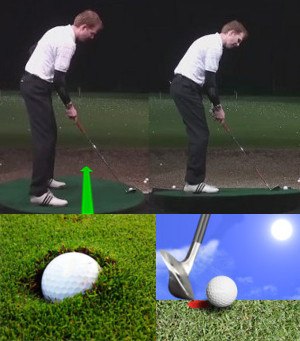
- Uphill or downhill lies. When the ground beneath your feet is not level, you’ll always be more likely to hit the ball fat. This is because the lack of a level playing surface makes it hard to move your body as you would normally during the swing. On a downslope, you may hang on your left side and make a steeper-than-normal backswing, which will lead to a steep downswing and the risk of catching the shot heavy. The opposite is true when playing on an upslope. You might get through the backswing okay in this situation but rotating your lower body and moving up the hill to reach impact can be tough. Often, the player will hang back during the downswing when playing on an upslope, and the shot will be hit fat as a result. To hit the ball as solidly as possible off uneven lies, the first step is to swing a bit softer. Balance is going to be tough anyway in this situation, you don’t need to make things worse by swinging as hard as you can. Select a club and shot in this kind of situation that will allow you to swing pretty easy while focusing on a good strike at impact. From there, adjust your stance at address to get as comfortable as you can, paying attention to how you are balanced. If you start balanced properly, it will be easier to stay that way throughout the swing and into the finish.
- Playing on soft turf. If you are playing on a course that is soft from recent rain or other conditions, you’ll want to be on high alert for fat shots. The issue here is that the soft turf won’t be quite as forgiving when you hit the ball just a little heavy. For instance, if you hit the ground just a bit behind the ball when playing on hard ground, the club may slide that last little distance into the ball and the shot could come off okay. That won’t happen when the ground is soft. Instead, the turf will eat up the club and you will lose speed rapidly through impact. To play well when the ground is soft, you need to strike the ball as cleanly as possible. In addition to focusing on balance, as always, you may also want to move the ball back in your stance just slightly to make it easier to reach impact before catching the turf. It will always be a bit of a challenge to hit clean shots on soft ground but paying attention to your fundamentals and keeping things simple will help.
- Short wedge shots. This is a classic spot for a fat shot to pop up in your game. When you need to play a wedge shot from a fairway lie, and that wedge shot requires something less than full power, you may have a tendency to hit it fat. The issue here is that you aren’t going to be making a full turn, and your lower body won’t be rotating as aggressively toward the target as it would be with a full shot. Also, you may feel like you are going to hit the ball too hard as the club approaches impact, so you might back off at the last moment and lose the speed out of your swing. These issues can lead to fat contact – in some cases, you may hit it so fat that the ball only travels a short distance in front of you. One of the best things you can do to address this issue is simply to practice these half-wedges more often. This is a part of the game that tends to be overlooked by amateur players, and the results speak for themselves on the course. Spend some time hitting partial wedges and you might find that striking them cleanly becomes a much easier task.
If you pay close attention to your game, and take note when you hit fat shots, you’ll likely start to notice some patterns. Most likely, you will be prone to fat shots in one part of the game more than any other. Once you notice which situations tend to give you trouble, you can get down to work on improving the way you handle those kinds of shots.
— Two Drills to Cut Down on Fat Shots
Performing practice drills is one of the best ways to limit the number of fat shots you hit during the average round of golf. While it isn’t realistic to get rid of fat shots entirely, you can make strides toward making sure these are rare mistakes rather than regular occasions. In this section, we have provided two drills which we hope will help you improve the quality of your ball striking as soon as possible.
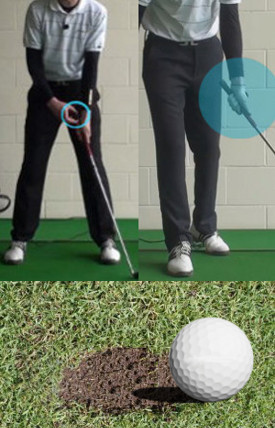
- The low drill. This drill is going to involve hitting some intentionally low shots on the driving range. You should really be working on low shots anyway as part of your regular practice routine, since they are so useful on the course, but in this case, we are going to use them as a drill to get away from scooping the ball at impact. You can’t hit solid low shots if you are scooping, so this drill is going to reveal some truths about your technique. To get started, hit a few shots with a seven iron while choking down on the handle by an inch or two. If you hit down through impact properly, and abbreviate your follow through a bit, you should be able to hit some low shots. When you start to find success, take note of the way the club feels as it moves through impact. Your hands should be pretty quiet at the bottom of the swing, as that will take the scooping action away and it should flatten out your ball flight. Then, when you move back to hit some regular full shots after you are done with the drill, remember how your hands felt and impact and try to do something similar on your full swing. In the end, you’ll hopefully be left with a move that allows you to strike the ball cleanly time after time while reducing your risk of hitting the ball fat.
- Back of the divot drill. This next drill is a good option when you are practicing on a natural grass driving range. Most likely, when you arrive at the range, there will already be at least a few divots in the hitting area. To get started with this drill, place your first practice ball at the back of one of those existing divots, just barely on top of the grass before the divot begins. Then, hit your shot with some kind of short iron and disturb as little of the grass as possible. Since the grass in front of the ball is already gone, and you are trying to miss the grass behind the ball by hitting down through impact, you should only take just a small sliver of grass from right underneath the ball. Then, after that first shot, place your ball in a similar position and hit again. This way, not only can you work on avoiding fat shots, but you can minimize the damage you do to the range by taking up as little grass as possible during your practice session.
These two drills certainly aren’t complicated, and they won’t take up much of your time during a practice session. Hopefully, they will have a positive impact on the way you swing down through impact. Try working these into your regular practice routine and the frequency of your fat shots should gradually be reduced.
— Fat Shots in the Short Game
It’s not only with the full swing that you can get into trouble with fat shots. You also may deal with fat shots in your short game, and they can be just as damaging here as when making full swings. Of course, you shouldn’t face too many problems with fat shots when you are putting, so what we are really talking about is chipping and pitching. Hitting your chip and pitch shots solidly time after time is not an easy task, but it is important if you hope to lower your scores.
The list below highlights some key points to keep in mind as you try to avoid fat shots in your short game.
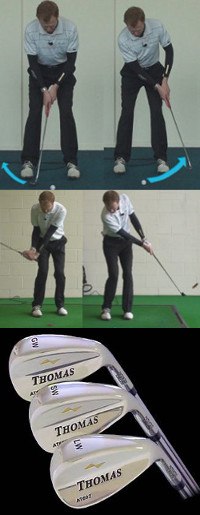
- Keep your hands moving. One of the biggest keys to striking the ball cleanly when chipping or putting is simply to keep your hands moving toward the target through the hitting area. If your hands stop moving, the club is going to stop moving as well – and it might not quite reach the ball in time to make impact cleanly. The problem here, of course, is nerves – if you get nervous on your chip shots, you might stop your hands out of fear, and the club may go into the grass before it reaches the ball. Before starting a swing for a chip or pitch shot, commit yourself fully to the shot and hand and decide that you are going to swing through with confidence. Not every shot will come off as you intended but committing to your shots is going to lead to the best possible results.
- Make things easier on yourself. It’s more likely that you will hit a highly-lofted club fat when chipping than it is that you’ll hit a fat shot with less loft. So, whenever possible, take the easier route and use less loft to reduce the chances of a mistake. For instance, if you have plenty of room to work with and a good lie, use a 9-iron or pitching wedge to hit your chip shot, instead of a sand wedge or lob wedge. You’ll be buying yourself a little extra margin for error, and that just might be the difference between hitting the shot fat and striking it perfectly. Golf is a hard enough game as it is, you don’t need to make it any harder by choosing an unnecessarily difficult shot.
- The right bounce. Using the right wedges can play a role in this discussion, as well. Specifically, you’ll want to pay attention to how much bounce is built into the sole of your wedges. More bounce means a more rounded sole, while a low bounce wedge is one with a rather flat sole. The right option for you depends largely on the conditions you will face on the course. If you play courses that usually feature soft turf, you will want more bounce, so the club can glide across the top of that soft turf without digging in. On the other hand, those who play on firm turf conditions will usually benefit from a lower bounce design, as that will make it easier for the leading edge of the wedge to slip in under the ball. Experiment with various bounce angles when picking out your wedges to make sure you have equipment that is a good match for your needs.
It’s a great feeling to stand over the ball and believe that you are going to make solid contact. That won’t always happen, of course, but believing that you are going to strike the ball cleanly is a great start and an enjoyable way to play golf. We hope the discussion in this article will help you reduce the frequency of fat shots in your game. Good luck!






